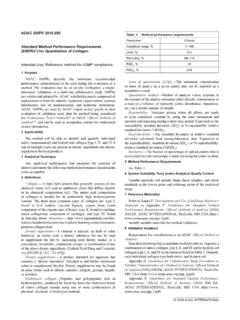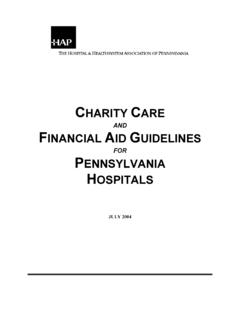Transcription of Appendix K: Guidelines for Dietary Supplements …
1 2012 AOAC INTERNATIONALThis Appendix contains three complementary documents for the validation of Dietary Supplements and botanical methods:Part I: AOAC Guidelines for Single-Laboratory Validation of Chemical Methods for Dietary Supplements and BotanicalsPart II: AOAC Guidelines for Validation of Botanical Identifi cation MethodsPart III: Probability of Identifi cation: A Statistical Model for the Validation of Qualitative Botanical Identifi cation MethodsPART IAOAC Guidelines for Single-Laboratory Validationof Chemical Methods for Dietary Supplementsand BotanicalsContents 1 Defi Method of Performance Characteristics of a Method of Analysis 2 Single-Laboratory Validation Preparation of the Laboratory Identifi Method of Analysis or Reference Ruggedness Specifi c Variablesa.
2 Analyte Additionb. Reextraction of the Extracted Residuec. Comparison with Different Solventsd. Comparison with Results from a Different Proceduree. System Suitability Checks 3 Performance Applicability (Scope) External Standard Internal Standard Standard Addition Reliability Repeatability Precision (sr, RSDr) Measurement Reproducibility Precision (sR, RSDR) Intermediate Limit of Reporting Low-Level Dichotomous Control Injection Duplicate Confi rmation of Stability of the Analyte 4 Report (as applicable) Applicability (Scope) Results of Identifi cation Performance DataAppendix K.
3 Guidelines for Dietary Supplements and BotanicalsUnder a 5-year contract (2003 2008) with the National Institutes of Health-Offi ce of Dietary Supplements , through the Food and Drug Administration, AOAC undertook an effort to validate methods for Dietary supplement ingredients of interest. As part of the initiative, AOAC adapted and revised the traditional Offi cial MethodsSM process to include single-laboratory validation (SLV). Methods were fi rst validated within a single laboratory to test their suitability and ruggedness without the complications of a multilaboratory collaborative study.
4 SLVs proved to be an excellent debugging tool for complex methods; problems found within one laboratory could be dealt with so that a stronger method went on to the collaborative study. The SLV process, thus, became a step in preparation for the collaborative SLV Guidelines were approved by the AOAC Offi cial Methods Board and Board of Directors in December 2002. 2012 AOAC INTERNATIONALGUIDELINES FOR Dietary Supplements AND BOTANICALS AOAC OFFICIAL METHODS OF ANALYSIS (2012) Appendix K, p.
5 Low-Level Stability DataAnnex A: Abbreviations and Symbols UsedAnnex B: Example of a Ruggedness TrialBecause of the time and expense required for the determination of modern analytes such as pesticide residues, industrial contaminants, veterinary drugs, allergens, botanicals, Dietary Supplements , and alternative medicines in complex matrices, there is considerable interest in obtaining acceptable methods of analysis faster and cheaper. It has been suggested that accreditation of laboratories, internal quality control, and external profi ciency exercises can improve laboratory performance to the point where interlaboratory validation is no longer an absolute necessity.
6 To this end AOAC INTERNATIONAL has been exploring alternatives to the full interlaboratory study design that requires the examination of a minimum of fi ve matrices by eight laboratories (see under method validation programs). These have included minicollaborative studies that reduced the required number of matrices and laboratories, the Peer-Verifi ed Methods Program, which merely required verifi cation of the analytical parameters by a second laboratory, Performance Tested MethodsSM for test kits, the developing e-CAM compiling program ( ), and the International Union of Pure and Applied Chemistry (IUPAC) sanctioned single-laboratory validation (SLV) protocol [Pure & Appl.]
7 Chem. 74(5), 835 855(2002)].The IUPAC single-laboratory protocol necessarily deals in generalities and specifi cally points out, The total cost to the analytical community of validating a specifi c method through a collaborative trial and then verifying its performance attributes in the laboratories wishing to use it, is frequently less than when many laboratories all independently undertake SLV of the same method. The protocol also indicates that the degree of validation depends upon the status of the method in the analytical structure.
8 At one extreme is the initial application of a well-established method in a laboratory that merely requires verifi cation of the capability of that laboratory to achieve the published performance characteristics. The opposite extreme is the initial presentation of a new method or the initial application of an established method to a new matrix or application. Methods that are developed in response to a continued need for compliance, surveillance, and enforcement of laws and contracts involving a number of laboratories are expected to proceed to a multilaboratory validated AOAC document is intended to present Guidelines for the evaluation of the initial use of a new or old method in a laboratory.
9 It assumes that a proposed or available method is fairly well developed, optimized, and stabilized, that it has been applied to some practical test samples with acceptable results, and that a description of the method and its initial performance results are available in some kind of document. The initiating or another laboratory must then decide if the demonstrated performance appears to be satisfactory for the same or for another the output from method development is the input to method validation, method developers cannot expect much input from method validators.
10 Although method validators may have had considerable experience in the analysis of practical analytical samples, they are not expected to have the basic knowledge to recommend improvement in methods, such as certain solvents as useful for extraction of certain classes of analytes or column-solvent combinations as useful for optimization of separations. Method developers are expected to bring methods to the point where they satisfy validation defi nition, SLV does not provide any information on what values would be expected on examination of identical test samples by other laboratories.












